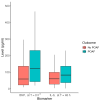Perioperative Changes in Plasma Nitrite and IL-6 Levels Predict Postoperative Atrial Fibrillation (POAF) and Acute Kidney Injury (AKI) after Cardiac Surgery
- PMID: 39199217
- PMCID: PMC11351338
- DOI: 10.3390/antiox13080971
Perioperative Changes in Plasma Nitrite and IL-6 Levels Predict Postoperative Atrial Fibrillation (POAF) and Acute Kidney Injury (AKI) after Cardiac Surgery
Abstract
Background: Postoperative atrial fibrillation (POAF) and acute kidney injury (AKI) are common yet significant complications after cardiac surgery, with incidences of up to 40% for each. Here, we assessed plasma nitrite and serum interleukin-6 (IL-6) levels before and after cardiac surgery to quantify the extent to which oxidative stress and inflammation contribute to POAF and AKI occurrence. Methods: We prospectively enrolled 206 cardiac surgical patients. Plasma nitrite and serum IL-6 levels were determined preoperatively and at 24 h, 48 h and 72 h postoperatively. The patients had continuous EKG monitoring for occurrence of POAF, while daily serum creatinine was measured for determination of stage 1 + AKI. Results: Postoperatively, 78 (38%) patients experienced AF, and 47 (23%) patients experienced stage 1 + AKI. POAF analysis: Age, ACE-inhibitor use, valve surgery and percent change in baseline plasma nitrite at 24 h postoperatively were associated with POAF in multiple logistic regression analysis. The inclusion of this new biomarker significantly improved the POAF prediction model (AUC 0.77 for clinical risk factors alone, to AUC 0.81). AKI analysis: A history of diabetes mellitus was associated with AKI in multiple logistic regression analysis, and the addition of preoperative IL-6 levels improved the prediction model for AKI occurrence (AUC 0.69 to AUC 0.74). Conclusions: We previously observed selective upregulation of NADPH oxidase isoform 4 (NOX4) in patients with AF, a critical causal role of NOX4 for AF in zebrafish and a robust inhibitory effect of nitric oxide (NO) on NOX4. Our data innovatively demonstrate that a reduction in circulating nitrite levels, likely implicative of elevated NOX4-mediated oxidative stress, independently associates with POAF and improves POAF prediction, whereas the inclusion of circulating IL-6 levels improves the prediction model for AKI. Therefore, therapeutic strategies to mitigate these pathophysiological sequalae of surgical stress may reduce the incidence of severe postoperative complications of POAF and AKI.
Keywords: ROS; acute kidney injury; atrial fibrillation; nitric oxide (NO); nitrite; post-operative complications.
Conflict of interest statement
The authors declare no conflicts of interest.
Figures





References
Grants and funding
LinkOut - more resources
Full Text Sources
Miscellaneous

